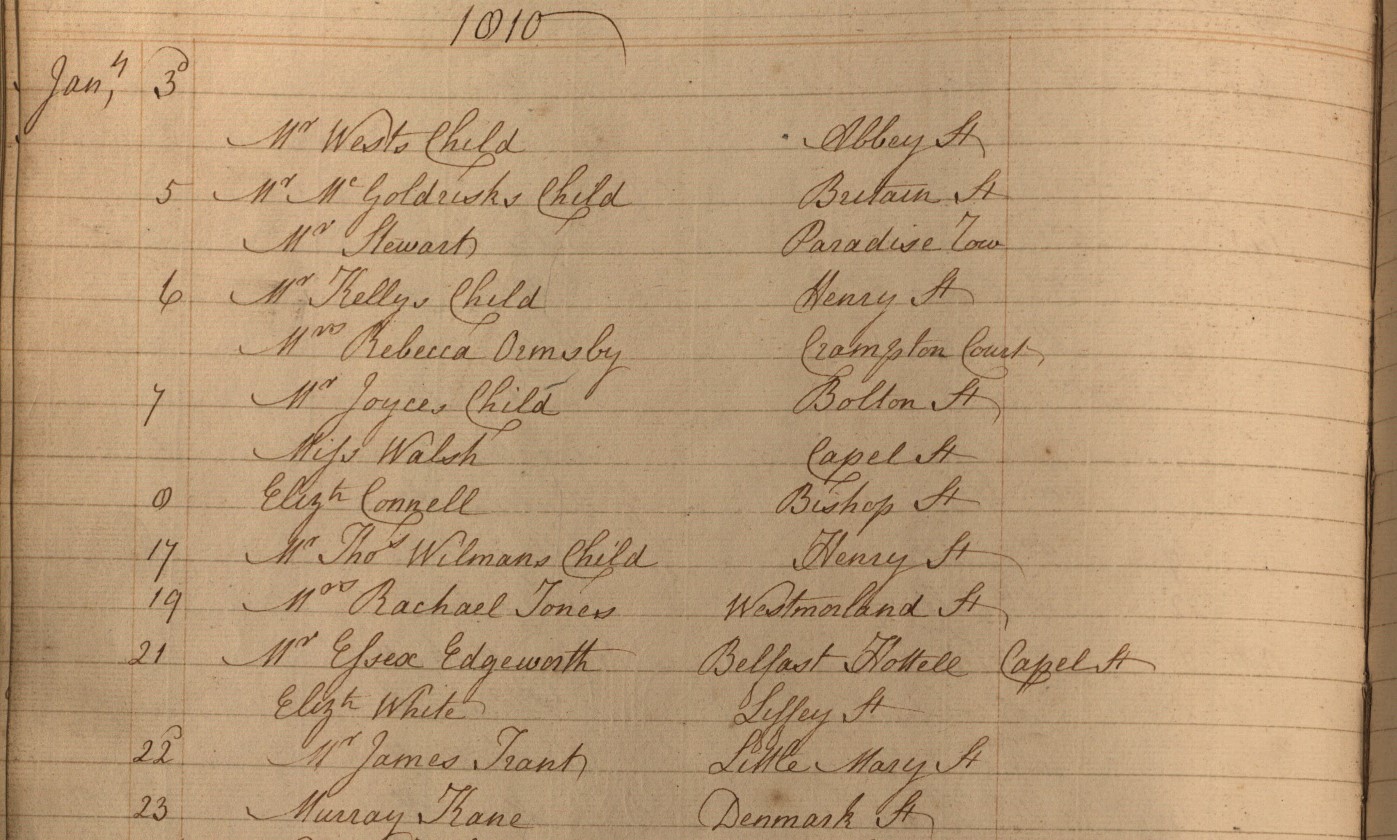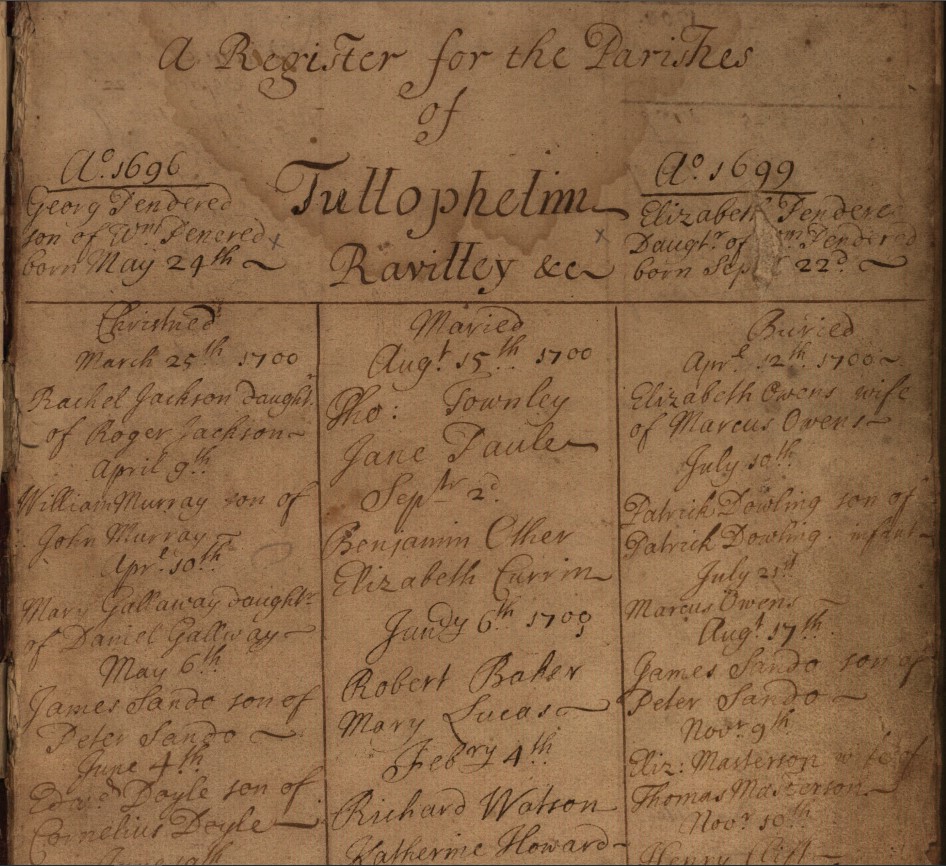Irish Church records
Church of Ireland Records
Records of the Established Church, the Church of Ireland, generally start much earlier than those of the Roman Catholic Church. From as early as 1634, local parishes were required to keep records of christenings and burials in registers supplied by the church authorities. As a result, a significant number, especially of urban parishes, have registers dating from the middle of the seventeenth century. The majority, however, start in the years between 1770 and 1820. The only countrywide listing of all Church of Ireland parish records that gives full details of dates is the RCBL catalogue, which can be downloaded from www.ireland.anglican.org/about/rcb-library/catalogues/parish-records. The Guide to Church Records: Public Record Office of Northern Ireland, (online, PRONI, 2010) gives details of PRONI's holdings. A composite county-by-county listing is free on this site.
Burials:

Unlike their Roman Catholic counterparts, the majority of Church of Ireland clergymen recorded burials as well as baptisms and marriages. These burial registers are often also of interest for families of other denominations; the sectarian divide appears to have narrowed a little after death, or perhaps the Anglican monopoly of burial grounds in urban areas may be responsible. The information given for burials rarely consists of more than the name, age and townland, making definite family connections difficult to establish. However, as early burials generally record the deaths of those born well before the start of the register, they can be the only evidence on which to base a picture of preceding generations, and are particularly valuable because of this.
Baptisms:

[Ballymodan baptisms: Click for larger image]
Church of Ireland baptismal records almost always supply only:
- the child's name;
- the father's name;
- the mother's Christian name;
- the name of the officiating clergyman.
Quite often, the address is also given, but this is by no means as frequent as in the case of Catholic registers. The omission of the mother's maiden name can be an obstacle to further research. From about 1820, the father's occupation is supplied in many cases.
Marriages:

As the Church of Ireland was the Established Church, the only legally valid marriages, in theory at least, were those performed under its aegis.
In practice, of course, de facto recognition was given to marriages of other denominations. Nonetheless, the legal standing of the Church of Ireland meant that many marriages, of members of other Protestant churches in particular, are recorded in Church of Ireland registers. The information given is not extensive, consisting usually of the names of the parties marrying and the name of the officiating clergyman. Even addresses are not common, unless one of the people is from another parish. More comprehensive material is included in records of marriage banns, where these exist. Although it was obligatory for notification of the intention to marry to be given in church on three consecutive Sundays, written records of these are relatively rare. After 1845, when non- Roman Catholic marriages were registered by the state, the marriage registers record all the information contained in state records, including occupations, addresses and fathers' names.
Marriage Licence Bonds:
As an alternative to marriage banns, members of the Church of Ireland could take out a Marriage Licence Bond. The parties lodged a sum of money with the diocese to indemnify the Church against there being an obstacle to the marriage; in effect the system allowed the better-off to purchase privacy. The original Bonds were all destroyed in 1922, but the original indexes are available at the National Archives. Transcripts and images are available at genealogy.nationalarchives.ie, FindMyPast.ie (after registration), and on LDS microfilm. The Dublin diocesan index was published as part of the Index to Dublin Will and Grant Books, RDKPRI 26, 1895 (1270-1800) and RDKPRI 30 1899 (1800-1858). The Genealogical Office holds abstracts of Prerogative Marriage Licence Bonds from 1630 to 1858 (GO 605-607), as well as Marriages recorded in Prerogative Wills (GO 255-6). For an explanation of the Prerogative Court see Wills.
Other Information:
As well as straightforward information on baptisms, marriages and burials, Church of Ireland parish records very often include vestry books. These contain the minutes of the vestry meetings of the local parish, which can supply detailed information on the parts played by individuals in the life of the parish. It should be kept in mind that since the Church of Ireland was in effect an arm of government, matters concerning non-Anglicans, such as poor relief, are also treated in these vestry books. They are not generally with the parish registers in the National Archives, but the Public Record Office of Northern Ireland and the Representative Church Body Library in Dublin have extensive collections. Click here for a full listing of RCBL vestry minutes.
Record Locations
After the Church of Ireland ceased to be the Established Church in 1870, its marriage records before 1845 and baptismal and burial records before 1871 were declared to be the property of the state: public records. Unless the local clergyman was in a position to demonstrate that he could house these records safely, he was required to deposit them in the Public Record Office. By 1922 the original registers of nearly a thousand parishes, more than half the total for the country, were stored at the PRO, and these were all destroyed in the fire there on 28 June that year.
Fortunately, 637 registers had been kept locally in secure storage, and local rectors had in many cases made a transcript before surrendering the originals. In addition, local historians and genealogists using the PRO before 1922 amassed collections of extracts from the registers. All these factors mitigated, to some extent, the loss of such a valuable collection. However, it has also meant that surviving registers, transcripts and extracts are now held in a variety of locations. The Appendix to the 28th Report of the Deputy Keeper of Public Records in Ireland lists the Church of Ireland parish records for the entire island, giving full details of the years covered and specifying those that were in the PRO at the time of its destruction. No information on locations is included.
The RCBL is the Church of Ireland's own repository for its archives and manuscripts, and it holds the original records of more than a thousand parishes, not all of them of genealogical interest. Except where the originals are too fragile, these records are open for public research. The online master list at goo.gl/4eHlIZ is the only comprehensive published guide.
In general, for the northern counties of Antrim, Armagh, Cavan, Derry, Donegal, Down, Fermanagh, Leitrim, Louth, Monaghan and Tyrone, surviving registers have been microfilmed by PRONI, and are available to the public in Belfast The Guide to Church Records: Public Record Office of Northern Ireland (PRONI, 2010, online goo.gl/6CjM6F) gives details. A digitisation programme has covered fifteen parishes at the time of writing (August 2018). For the moment the digital transcripts are only searchable in the PRONI research room. For those counties that are in what is now the Republic - Cavan, Donegal, Leitrim, Louth and Monaghan - copies of the PRONI microfilms are available to the public at the RCBL, although the RCBL master list does not specify this. The vast majority of all surviving historical records for the rest of the Republic are now in the RCBL, with some transcripts and images online. See 'What's online?'. If the surviving records really are only available locally, the current Church of Ireland Directory will supply the relevant name and address (www.ireland.anglican.org/find-a-church).
Many surviving Church of Ireland records have also been transcribed by the member centres of the Irish Family History Foundation on www.rootsireland.ie. A full listing, with details of years covered is in the county-by-county listings.